The PC Power & Cooling Pro-Source is an industrial quality Pure Sine Wave Uninterpretable Power Supply capable of keeping your system running for 12 minutes under a 600 watt load.
INTRODUCTION
PC Power & Cooling (Acquired by OCZ in 2007) has long been a serious player in the computer power supply arena. We were pleased and surprised when they contacted us about a Uninterpretable Power Supply (UPS) called the Pro-Source 1500. The UPS arena is new for PC Power & Cooling but given their reputation for rock solid large single rail power supplies we’re betting that the Pro-Source 1500 is just as dependable as the PSU so many people have come to know and love. While many PSU companies ran with the crowd and went modular and multiple rail PC Power & Cooling staunchly insisted the modularity in a computer PSU, and the removable power cords, change the PSU’s ability to deliver clean power and add resistance to the delivered power. As for multiple rail PSU, PC Power & Cooling doesn’t manufacture those, they stuck with large single rail PSU insisting that a single large rail delivers cleaner more dependable power. A company that refused to profit from trends and insists on doing things the single best way might not have the profitability of trendy companies, but you can bet that their product will be top of the line and no compromises were made in the manufacture of any of their products.
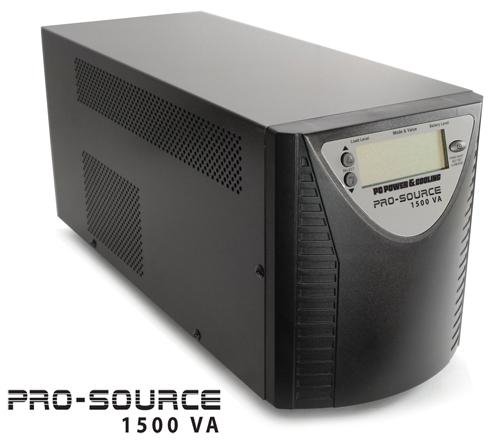
Little Known Facts About Wall Current
The Average Consumer is subjected to 120 various power problems each month, that’s an average of (Approx) 4 times a day making power protection crucial for the safety and longevity of your computer (and electronics). Your every day surge protector isn’t going to cover the gamut of power problems you can expect. A Surge protector protects against one thing, power surges. Spikes in power that exceed normal operating voltages. They don’t protect against brownouts, and power sags or power blackouts. Most of the inexpensive surge protectors won’t even protect (adequately) against power surges let alone any of the power brownouts, outages, or power sags. The most effective defense against power problems is to unplug the computer or electrical appliance, not a very feasible solution because unplugged you have a paperweight. The next best thing is a high quality Uninterpretable power supply. Those come in two common forms. Stepping Sine wave (Low quality UPS) and Pure Sine Wave Technology (High quality UPS). An Uninterpretable Power Supply is a combination of stored power, in the form of a battery (or batteries) and a collection of circuits that detect potential power problems from wall current and prevent power spikes, brownouts, power sags, and provide enough power in the event of a blackout to keep your system running long enough to shut it down and prevent damage and data loss. Higher end UPS also provide a software/hardware method of shutting the computer down in your absence ensuring that in catastrophic power loss situations your system is powered down safely.
Quotes About Power Problems
Power problems are the second leading, and most preventable cause of computer downtime. Source: HP Whitepaper: Increasing Single System Availability
Power problems are the leading cause of data loss, 15 times more frequent than computer viruses. Source: Contingency Planning
Sags in power supply can cause up to 87% of computer crashes. Source: AT&T Bell Labs
In the USA up to 150,000 people are affected by a power loss each day. Source: Power Planning Institute
Back To The Introduction
With the PC Power & Cooling Pro-Source 1500 using pure sine wave technology and providing 12 minutes of backup power at a 600 Watt draw we moved it to a mission critical role quickly. With the Pro-Source 1500 in place we no longer need to worry about a dirty power supply coming in from the wall contaminating our benchmarks. Across 3 weeks intensive testing, and hundreds of power readings both from the wall and (Past the Pro-Source) going to the Computer PSU we’ve come to know the capabilities of the Pro-Source pretty well. What we didn’t realize, and is often taken for granted, is that the power from the wall (at least here) can be really polluted and fluctuates a lot. We held out for a few major storms and while a lot of the electronics were unplugged we kept a test rig running during thunder and lightning that would scare an electric company lineman into soiling his jumpsuit. The results are quite impressive.
About PC Power & Cooling
On April 19,1985, PC Power & Cooling began operations in a small warehouse just outside of San Diego, CA. Founded by Doug Dodson, a commodity trader and electronic hobbyist, the company’s first products were custom fans to cool and quiet computers.
In 1986, the company introduced its Silencer 150 and Turbo-Cool 200, the industry’s first ultra-quiet and high-performance power supplies. Other high-end products followed, the reviews were great, and the company continued to grow. In 1991, the company moved to its current facility in San Diego, CA.
Over the last 22 years, PC Power & Cooling has produced many innovative products including: the first CPU cooler, the first PC heat alarm, the first independently-regulated PC power supply, the first redundant power system, the first NVIDIA-certified SLI supply, the first One Kilowatt computer power supply, and the first power supply with its own certified test report (Turbo-Cool 1KW).
PC Power & Cooling takes pride in its loyal and knowledgeable customer base, its ultra-reliable product line, its professional and friendly staff, and its financial strength.
Voltage Terminology
In order to better present the information about the Pro-Source 1500 from PC Power & Cooling we felt the need to go a little in depth about voltage terminology so that you may have a better understanding about what it’s capabilities are. It will also help to prevent a landslide of emails asking about the different terms we use. For the more lighthearted emailers we occasionally get, “No A Bra won’t help prevent sag in your computer.”
Amps An amp is the basic unit of electric current. It measures the amount of current that a device needs to operate.
Brownouts A brownout is a reduction of your incoming voltage. Brownouts are the most common form of power problems, accounting for over three-quarters of all power problems. When brownouts occur, the lower voltage causes your computer system to work harder then it has to. This can cause excessive wear and premature failure of critical components.
Joules A joule is a unit of work or energy. Joule ratings are given on UPS systems and surge protectors to provide an idea of how much surge protection they provide. Look for units that provide joule ratings of 400 or greater to insure exceptional protection for your system.
Sag A voltage sag is another name for a brownout.
Spike A spike is an instantaneous increase in voltage. Spikes can be cause by such things as lightning or overloaded power grids. Spikes can cause damage to your computer, modem and other critical components.
Surge A surge is a sudden transient increase in your electrical current. Surges are usually caused when items that draw a large amount of electricity (air conditioners, refrigerators, copiers, etc…) are turned off. The extra power that these items were using is then released back into the power lines.
UPS Abbreviation for Uninterpretable Power Supply.
Volt-Amps When purchasing a UPS system, you need to know how much capacity you need. This capacity is measured in volt-amps
PCP&C commonly used abbreviation for PC Power & Cooling (To satisfy the staff grammar police)
Questions to ask yourself if you think you might need a UPS
Are you currently using a power protection device for your computer system? (Other than that $7 Surge Protector under your desk)?
Do you live in an area with frequent thunderstorms or lightning or a bad power grid?
Do you experience computer lock-ups or does your computer run slow?(Yes under powering your computer from the wall can cause that just like a fading PSU can)
Do you ever notice the lights dim for a brief period when laser printer, air conditioning, refrigerator or other electrical apparatus is activated?
Do you have important pictures or data stored on your computer?
Are you concerned about damage to your computer system due to long-term effects of fluctuating incoming voltage levels?
Would you like your equipment to run cooler and last longer?
What is Pure Sine Wave Technology?
Like light and sound, electricity travels in waves. A pure sine wave form is a name for the physical rounded shape of the wave the electricity travels in. Utility power comes in sine wave form which allows computer components and electrical motors to run cooler and more efficiently. Pure sine wave products are designed for applications which demand perfect power and top of the line power protection.
Benefits Of Pure Sine Wave Technology
- Noise is eliminated which means no more lines on your television and no hum in your sound system
- Computers operate more accurately
- Extends the life of electronic equipment
- Electronic equipment runs cooler, therefore more efficiently
- Eliminates static or hum on telecommunications equipment
- Electronic motors run at their intended speed
- Sensitive electronics operate properly and retain settings
SPECIFICATIONS
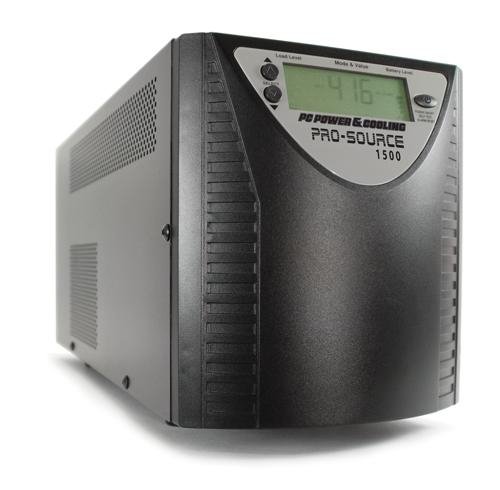
| Model | Pro-Source 1500 UPS |
| VA Rating | 1500VA |
| Watts | 900W |
| Input Voltage Range | -20$ ~ +24% for selected output voltage |
| Output Voltage | 100V/110V115V/120V Selectable |
| Output Frequency |
|
| Temperature | 0 to 40C (32F to 104F) |
| Noise | Audible: 20-40 dBA (at 1M from surface of unit) |
| Voltage Waveform | Pure Sine Wave |
| Outlets | 6 (NEMA 5-15) |
| Dimensions | 17.7 x 7.9 x 7.1 inches (D x H x W) |
| Weight | 46.3 lbs |
| Warranty | 3 years |
The features and specifications on this beast aren’t well represented by a simple table so in a moment we will have to go into deeper specifications pulled from the PCP&C webby. Like we mentioned earlier this is the PC Power & Cooling Pro-Source 1500. That’s rated in VoltAmps, if you don’t know what a VoltAmp is refer back to page two which explains the terminology. Maximum Watts 900, to see how far we could push the Prosource we hooked it to Quadzilla and stuck 3 GTX-285’s in the mix.
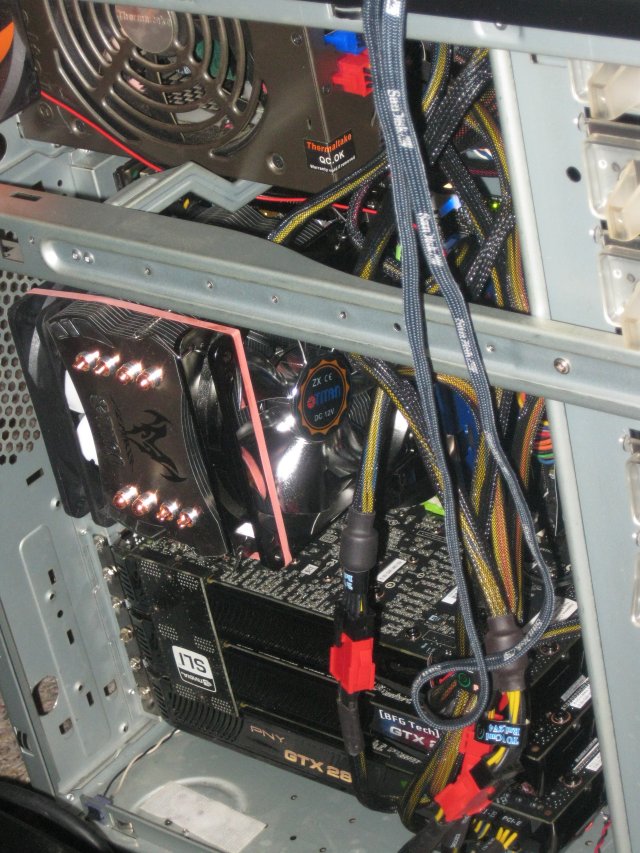
That’s the heaviest load we could pull from our selection of GPU’s and is about the heaviest load you would ever see. Probably heavier than 99.9% of all computer users will ever see. Why did we choose the Triple GTX-285’s?
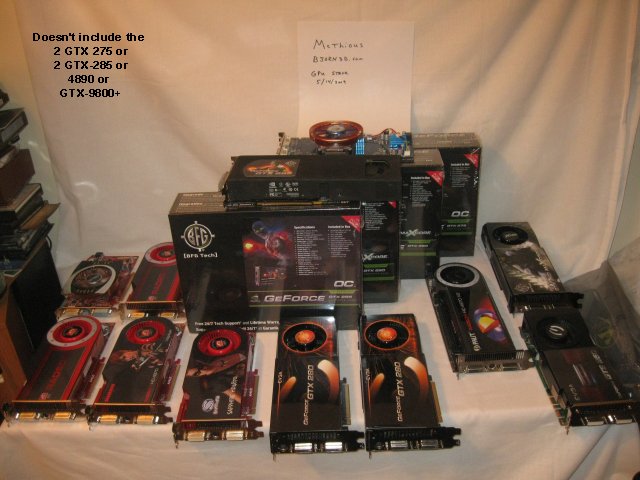
We were running low on GPU’s that day. So how much voltage did that configuration pull?

It pulled 758 Watts with the benchmarks running. So even in a massive machine running a Core i7 965 Overclocked to 3.74 GHz running 3 GTX-285’s with a nice 50 MHz OC on all three GPU’s, running Vantage and Prime 95 driving the rig as hard as it would go the Pro-Source 1500 is good to go. We measured voltage pull from the wall in this shot. We deliberately cut the wall power, yes we were hesitant to do that, but the Pro-Source kept the rig running for 8 minutes at which time we shut the test down and still had a little battery power left. We really didn’t want to let the Pro-Source run completely out of power while connected to several thousand dollars worth of hardware. We’re dedicated, but draining the Pro-Source while connected to a rig that’s valued upwards of $5k, were dedicated not mentally challenged.
If we stopped the review right here that alone should be enough to convince you of the worth of the Pro-Source 1500, we trusted a machine worth about $5000 to it and it came away unscathed.
Specifications Continued
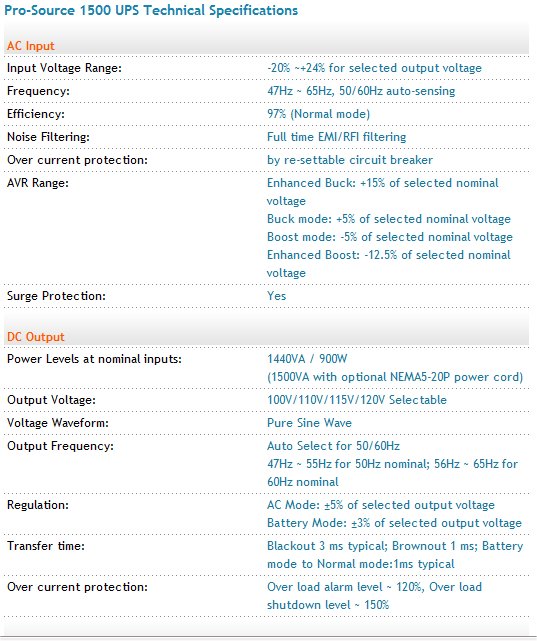
The Pro-Source 1500 will run at -20% to + 24% of the selected output voltage. So if your selected output voltage is 100v it will run on 80v to 124v and still provide good clean power to your electronic equipment. It will accept voltage from 47 Hz to 65Hz and autosenses 50/60Hz input voltage. In the USA we use 60 Hz voltage but other countries don’t so the Pro-Source will operate here in the USA and allows for other operating modes in countries that don’t use the 60Hz voltage we use.
The Pro-Source 1500 also features full time EMI (ElectroMagnetic) and RFI (Radio Frequency Interference) filtering. The Enhanced Buck mode (when the UPS takes an overvolt and turns it into nominal operating voltage, called bucking down) will take a +15% overvolt and turn it into normal operating voltage. Enhanced Boost mode (When you have a power sag/brownout) will take a -12.5% voltage sag and again turn it into normal operating voltage. Unlike lesser UPS that use Stepping Sine Wave technology that average the voltage to approximate the correct voltage, the Pro-Source uses Pure Sine Wave Technology to provide the correct voltage all the time. To prevent overvoltage the Pro-Source will read voltage from the wall and if it sees 120% of the nominal voltage it will sound an alarm. If it sees 150% of the normal voltage it will shut down to prevent damage to it and your equipment.
Let’s get a little less geeky for a moment. The Pro-Source will prevent overvolting and undervolting. It filters out the excess voltage, provides extra voltage during brownouts, and provides enough voltage to run the machine about 12 minutes at a 600w draw during a blackout. During a Blackout it will take 3 ms, during a brownout it will take 1 ms, and from battery power to normal mode 1 ms. Worst case in 3/1000’s of a second during a blackout the Pro-Source will have normalized power to your electronics. It won’t, however, get up and get you a soda, so we’ll have to dock points for that.
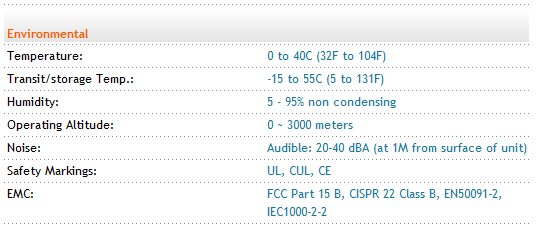
Operating temperatures 32° F to 104° F which should be in the range most end users keep the environment at while running their rigs. As will almost all electronics the UPS needs a non condensing environment to operate in. It’s like a glass of iced tea with a lot of ice on a hot day, beads of water form on the outside of the glass, beads of water on your Pro-Source might make an electrical connection and short it out. The thing we like least about the Pro-Source so far is the noise level. It uses an 80mm fan to keep the unit cool and average noise level is about 30 dBA so quiet is out of the question. Other than the slightly whiny fan the weight is pretty high but you can expect the weight knowing that it contains three sealed lead acid batteries. The Pro-Source comes in at a hefty 46 LBS so expect to pay a little for shipping, and use good lifting practices when you pull it out of the carton.
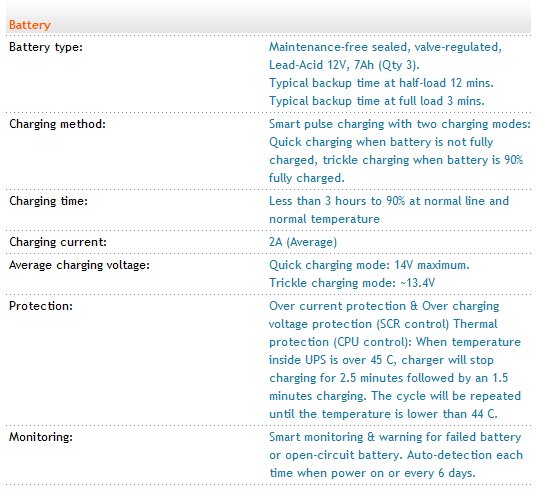
Half load runtime is expected to be 12 minutes provided the batteries are fully charged, full load runtime is 3 minutes. We loaded it to well 785w from the wall and got 8 minutes runtime with power to spare. The Pro-Source offers two charging modes (Auto selected by the UPS), one is trickle charging when the Pro-Source is at 90% or better charge, and Quick Charge when it’s below the 90% level. Charging time to 90% charge 3 hours, we had 100% charge in about 4 hours after discharging the Pro-Source to a completely drained state. To drain the Pro-Source 1500 we hooked a table lamp to it and let the table lamp completely drain the battery backup power. You should completely drain the Lead Acid batteries once every 6 months then recharge them completely. draining and recharging them helps to ensure the longevity of your UPS. The Pro-Source will let you know if one of the batteries goes bad or a terminal connector has managed to come loose.
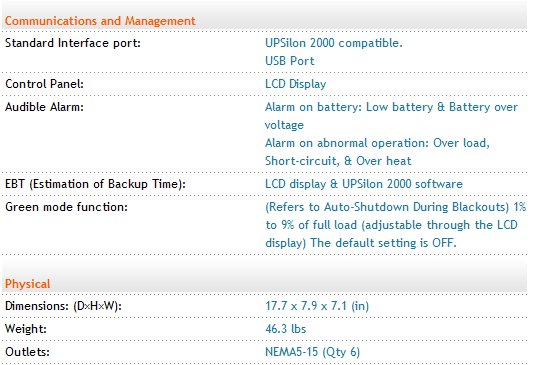
The Pro-Source not only offers voltage protection for the electronics it’s hooked to, but can use smart monitoring through a USB port and the included software has a variety of shutdown options. Say the power went off and you want the Pro-Source to shut the rig down in one minute (or any increment up to the full run time) you just tell the included software to shut the rig down and the Pro-Source will shut it down at the prescribed time. You can also run a network patch cable to the Pro-Source and then to your devices and it offers network protection. The control panel is an LCD screen and a lot of the functions and settings of the Pro-Source are controlled from the front LCD. It would have been a nice touch if the same settings could be controlled from the front panel or the software. Some of the settings you press more than one button and wait on a panel change then cycle through options. Most UPS tend to set in out of the way places that aren’t exactly easy to access so software setting the options would be nice.
Alarms consist of Low Battery, Battery overvoltage, abnormal operation, Overload, Short-Circuit and Overheat. The front panel will tell you how much backup time the Pro-Source thinks you have, this is an estimated number based on the voltage draw at any given moment. It’s not a good idea to have a blackout and try and run until the last minute left on the indicator, you might defeat the whole purpose of the Pro-Source trying to run every second you possibly can. By default the Pro-Source will shut the computer down when you experience a blackout, that’s adjustable by the front panel.
While the Pro-Source is a fairly small unit, it is about as long as a normal mid-tower computer chassis, and resembles a small Lanbox chassis. The small size will fool you because the weight comes in at 46.3 lbs due to the three lead acid batteries in the chassis. You get a total of 6 outlets on the back of the Pro-Source and their NEMA5-15 (Normal grounded 3 prong).
PICTURES & IMPRESSIONS

The PC Power & Cooling Pro-Source 1500 comes in a sturdy dual wall construction cardboard box. It has some interesting features listed on the box. The Pure Sine Wave technology is displayed, and that it’s line interactive. The Pro-Source is controlled by a microprocessor and adjusts for variations in incoming current.

The front of the Pro-Source you find the LCD control panel, we were a little shocked to find only 3 buttons and using different combination’s of buttons you can set the functions of the Pro-Source. It’s a little like setting a digital watch, hold down on two buttons until a menu pops up then select the menu item you want. Your probably going to want to keep track of the manual and actually read it, then make sure you keep the manual in a location you can find it in case you need it. Placing the manual in an envelope and taping it to the side of the Pro-Source was our solution.

The Pro-Source has a top venting system that consists of mesh like holes in the chassis, the 80mm fan seen here is a little noisy for our tastes but most UPS are in out of the way locations, under desks or behind something so the noise isn’t to bad. Figure between 20 dBA and 40 dBA with the average noise running at 30 dBA.

The back of the Pro-Source has a standard Serial port, a USB port, a network patch cable pass through, and 6 standard 3 prong electrical outlets. You’ll also find a reset button on the bottom right should you ever encounter a serious fault or the Pro-Source decided it has seen a seriously dangerous voltage situation you will need to push that button to reset it. We saw a few storm spikes in voltage that sounded the overvolt alarm but nothing we saw tripped the reset button. Notice the Remove sticker on the bottom right, we’ll get to that a little later.

Here’s a slightly different angle of the back of the Pro-Source for those of you that want a better look.

The side opposite the fan is nothing more than a couple of meshed sections for better ventilation. Notice the finish on the Pro-Source is polished piano black.

We wanted to toss this shot in to point out the amount the Pro-Source crushes the padding on the stand we had it on. Keep in mind your looking at 46.3 lbs of “Ouch I hurt my back” if you don’t lift it properly and give it the respect it calls for.

Included with the Pro-Source you’ll find a USB cable, Serial cable, network patch cable, software disk, manual and a little red circuit completer. Read on to find out about the circuit completer.

We already know at least a few readers will buy the Pro-Source and have the attitude “We don need no stinking manual”. So to avoid the landslide of emails saying you said it was a good product and we plugged it in and it didn’t work so we sent it back emails we are going into a little setup detail.
The lower left back of the Pro-Source you find a remove sticker on a panel, take your Phillips screwdriver and remove that small panel.

Once removed you’ll find a slot for the circuit completer. This is common on a lot of UPS type devices, to complet the circuit on the batteries you must insert the completer. This way if something shifts during shipping the batteries won’t get shorted. We can’t say how yours will arrive, but within 10 minutes of opening the package we had a full charge status indicator on ours. Shipping batteries with a full charge and no protection against accidental short isn’t a good idea so PCP&C uses a circuit completer.

This is the circuit completer, insert it into the red slot on the back of the Pro-Source.

Now with the circuit completed replace the panel you removed and your ready to charge the Pro-Source for the recommended 8 – 10 hours prior to it’s first use.
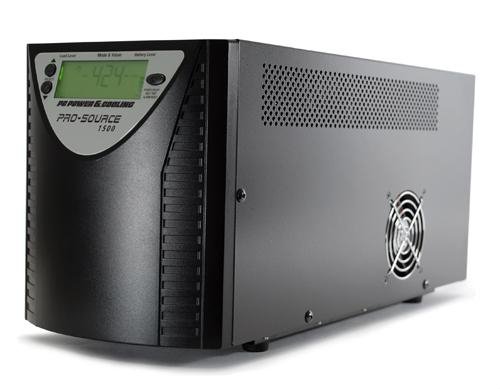
Then finally here’s a shot of the Pro-Source up and running and showing 424 minutes run time on the LCD. Typically with nothing plugged into the Pro-Source or the electronics plugged in but powered off it reads about 400-430 minutes runtime. You won’t get that much runtime with a fully powered computer attached to it. Please note that the Pro-Source is suitable for Computer hardware and they recommend draining it with a table lamp but it’s listed as not suitable for home appliances. We would assume that it’s suitable for anything that requires less load than it’s rated for but the sticker and manual say Computer Hardware only.
Testing Method
To test the Pro-Source initially we broke out two Kill A Watt voltage measurement devices and attached one to a heavy duty extension cord, we plugged the Pro-Source into the first Kill A Watt (p4400) so that we could see the voltage pull from the wall. Then we plugged a Kill A Watt into the back of the Pro-Source to measure the voltage delivered from the Pro-Source to the Computer. We moved the second Kill A Watt from outlet to outlet occasionally to make sure all 6 were operating within normal range. Frankly it didn’t matter where we plugged the second Kill A Watt into the Pro-Source, all the outlets delivered clean voltage.
Once we had the Kill A Watt’s hooked up and the Pro-Source setting directly in front of us on the test bench we proceeded to compute normally for a few days making an hourly check on input (Wall) and output (To the computer) voltage. We made a total of 96 hourly readings.
We gamed with the Pro-Source, did normal everyday computing, hooked up Triple SLI GTX-285 for load testing. We also cut power to the Pro-Source and measured how long it would sustain a rig with no power, we cut power to the Pro-Source 6 times.
After all that testing we just needed a few thunder storms close to us so we could see some brownouts, a power outage, and a couple of power surges. We used a low end test rig for the storm, but for the rest of the testing we used our high end Core i7 965 rig.
Test Rig
| Test Rig “Quadzilla” |
|
| Case Type | Top Deck Testing Station |
| CPU | Intel Core I7 965 Extreme (3.74 GHz 1.2975 Vcore) |
| Motherboard | Asus P6T6 (SLI and CrossFire on Demand) |
| Ram | Corsair Dominator (9-9-9-24 1.5v) 6GB Kit |
| CPU Cooler | Thermalright Ultra 120 RT (Dual 120mm Fans) |
| Hard Drives |
SuperTalent UltraDrive (FTM28GX25H) 128 GB |
| Optical | Sony DVD R/W |
| GPU | BFG GTX-260 MaxCore Drivers 182.20 |
| Case Fans | 120mm Fan cooling the mosfet CPU area |
| Docking Stations | None |
| Testing PSU | Thermaltake Toughpower 1200 Watt |
| Legacy | None |
| Mouse | Razer Lachesis |
| Keyboard | Razer Lycosa |
| Gaming Ear Buds |
Razer Moray |
| Speakers | None |
| Any Attempt Copy This System Configuration May Lead to Bankruptcy | |
Testing Results
We were on the verge of working up some lengthy charts and got as far as entering about 14 of the 96 hourly results when it struck us that it was a little pointless. No matter the input voltage which ranged (non storm) from 112-127v the output voltage was always 115v. We had the Pro-Source set to output 115v rather than 110v. The voltage was always level and stable even during brownouts. We were most impressed with the Storm testing results.
During two very large storms we experienced some serious thunder and lightning, at one point we had lightning so close that it shook the building. That’s a pretty close hit. During the storm we saw numerous severe brownouts, two short power outages, and voltage spikes up to 147v, the Pro-Source beeped at us and the overvolt indicator displayed for a couple of seconds then the LCD went back to normal. During the brownouts we kept an eye on the input voltage which dropped as low as 91v, during the brownouts we were reading 115v output. The test rig we used for storms was a low end single core AMD Sempron system with a 19inch CRT monitor. While we trust PCP&C and the Pro-Source 1500 we didn’t want to put a $5k rig in danger, lightning strikes are nothing to play with and during storms you really should just unplug electronics. While UPS systems will protect against most electrical threats to your system nothing we’ve seen will protect against a close or direct lightning hit 100% of the time.
We ran some Triple SLI GTX-285 SLI on the main test rig and pushed wattage up to 785 watts to test the load capacity of the Pro-Source 1500 which is as high as we could push it without plugging in non computer components. The Pro-Source ran fine at that wall draw and is rated to 900 Watts. With a nicely overclocked Core I7 965 running at 3.74 GHz and 3 GTX-285’s chugging as hard as they can go, we could only manage 785 watts.
We had two blackouts during the storms, the test rig never even blinked, it continued to run like nothing had happened and three minutes into the blackout the Pro-Source shut the test rig down. When we artificially cut power to the Pro-Source the same thing happened, the computer continues to run until the software shuts the computer down or the batteries are drained.
Total run time on a Core i7 965 with a normal configuration and a single GTX-285, wall draw 400w, 14 minutes and the UPS let us know that the battery was low and we shut it down. Total time on a Toshiba Laptop with a 17 inch LCD and an Intel T5300 Dual Core CPU before battery power on the Laptop kicked in was 53 minutes.
For some reason people seem to think that you’ll be able to run a computer on a high end UPS after the power has failed. They are not designed for that. The main function is to make sure you are getting good clean delivered power no matter the state of the wall to UPS power. Then in the case of power failure shut the machine down safely to avoid equipment damage and data loss. The Pro-Source is extremely efficient at that. Comparatively speaking we have some APC (American Power Conversion) UPS laying around rated to 350w and some of the test rigs will accept them and some won’t even turn on because of the stepping sine wave technology. The same test rig we used for the Pro-Source we tested on the APC UPS and the test rig wouldn’t successfully shut down before the APC UPS gave out and started beeping at us. That was with the APC UPS set for immediate shutdown. The Sempron test rig wouldn’t accept the APC UPS at all and refused to power up. Probably because all we had laying around at the time of testing was a bunch of high end high quality power supplies.
Performance on the Pro-Source was spot on in every testing scenario we could come up with including the slightly insane “Let run a computer during the worst electrical storm of the year” test. Which as we mentioned we don’t recommend in any situation.
CONCLUSION
We like the performance of the PC Power & Cooling Pro-Source 1500. The Pro-Source 1500 gave us good stable voltage during conditions any sane person would just unplug their rig and read a book. We read almost a hundred separate voltage input and output readings across a 2 week span with the Pro-Source 1500 setting at eye level on the test bench and have an entirely new appreciation for Pure Sine Wave Technology and the need for Uninteruptable Power Supplies. In most cases not more than a minute went by before the wall voltage was going up or down showing us just how bad it really was. When we were kicking on a 12,000 BTU air conditioner, we were using to simulate brownouts, the voltage coming into the Pro-Source would drop as low as 94v but the output voltage remained steady.
We threw everything we had in our bag of tricks at the Pro-Source 1500 including Triple SLI GTX-285’s, two lightning storms and cutting the power to the Pro-Source manually. Nothing we tried had any significant effect on the output voltage.
The Pro-Source reliably shuts the computer down during power outages, protects against overvoltage, undervoltage, catastrophic power failure and shuts the rig down during power outages. Now if we could just get it to go to the fridge and get us a soda we’d marry it.
We are using an addition to our scoring system to provide additional feedback beyond a flat score. Please note that the final score isn’t an aggregate average of the new rating system.
- Performance 10
- Value 8
- Quality 10
- Warranty 9
- Features 10
- Innovation 10
Pros:
+ Good Clean Voltage
+ Shuts Rig Down Safely During Power Outages
+ During Brownouts Voltage Remains Stable
+ During Overvoltages Power Output Remains Stable
+ Alarms For Overvolt
+ Auto Shutdown for Extreme Overvoltage
+ Peace Of Mind Operating An Ultra High End Rig
Cons:
– Little Noisy For Our Tastes
– Little Expensive But Inline With Other UPS Of This Wattage ($300)
The consistent excellent performance of the Pro-Source 1500 in the worst testing we could throw at it and the stable voltage it fed the test rigs during severe lightning storms earn it a:
Final Score: 9.5 out of 10 and the Bjorn3D Golden Bear Award.
 Bjorn3D.com Bjorn3d.com – Satisfying Your Daily Tech Cravings Since 1996
Bjorn3D.com Bjorn3d.com – Satisfying Your Daily Tech Cravings Since 1996




